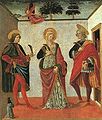Saint Cecilia
| Saint Cecilia | |
|---|---|
Saint Cecilia by Guido Reni, 1606[1] | |
| Virgin and Martyr | |
| Born | 2nd century AD in Rome |
| Died | 176–180 or 222-235 C.E.[2] in Sicily |
| Venerated in | Roman Catholic Church Eastern Orthodox Churches Eastern Catholic Churches Anglican Communion |
| Canonized | Pre-Congregation |
| Major shrine | Santa Cecilia in Trastevere, Rome |
| Feast | November 22 |
| Attributes | flute, organ, roses, violin, harp, harpsichord, singing |
| Patronage | Church music, great musicians, poets; Albi, France;Archdiocese of Omaha, Nebraska; Mar del Plata, Argentina |
- For other uses, see Saint Cecilia (disambiguation).
Saint Cecilia (Latin: Sancta Caecilia) is the patron saint of musicians[3] and Church music.[4] Her feast day is celebrated in the Roman Catholic, Eastern Orthodox, and Eastern Catholic Churches on November 22. She is one of seven women, excluding the Blessed Virgin, commemorated by name in the Canon of the Mass. It was long supposed that she was a noble lady of Rome who, with her husband Valerian(us) and his brother Thateus, suffered martyrdom, c. 230, under the Emperor Alexander Severus.
The research of Giovanni Battista de Rossi,[5] however, appears to confirm the statement of Venantius Fortunatus, Bishop of Poitiers (d. 600), that she perished in Sicily under Emperor Marcus Aurelius between 176 and 180. A church in her honor exists in Rome from about the 5th century, was rebuilt with much splendor by Pope Paschal I around the year 820, and again by Cardinal Paolo Emilio Sfondrati in 1599. It is situated in Trastevere, near the Ripa Grande quay, where in earlier days the Ghetto was located, and is the titulus of a Cardinal Priest, currently Carlo Maria Martini.
The martyrdom of Cecilia is said to have followed that of her husband and his brother by the prefect Turcius Almachius.[6] The officers of the prefect then sought to have Cecilia killed as well. She arranged to have her home preserved as a church before she was arrested. At that time, the officials attempted to kill her by locking her in an overheated sweat-house (bathhouse). However, the attempt failed, and she was to be beheaded. The executioner attempted to decapitate her three times unsuccessfully, at which time he fled. Cecilia survived another three days before succumbing. In the last three days of her life, she opened her eyes, gazed at her family and friends who crowded around her cell, closed them, and never opened them again. The people by her cell knew immediately that she was to become a saint in heaven.[4] She was a friend to all.
The skull of Saint Cecilia is kept as a relic in the cathedral of Torcello.
Patroness of church musicians
Cecilia's musical fame rests on a passing notice in her legend that she praised God, singing to him, as she lay dying a martyr's death.
The connection between her and the art of which she has become the patron saint does not seem to date back much before the 15th century.[7] She soon became popular, and by the second half of the 16th century substantial festivals and celebrations in her honor (and that of music in general) began to be recorded, the earliest of them in Normandy. It was just over 100 years before the fashion crossed the channel [to England] with the festivities of 1683 which attracted three celebratory Odes, all set to music by Purcell.
Innumerable paintings and stained glass windows depict her at the organ (inevitably one more advanced than any she could have known). She is represented in the The Ecstasy of St. Cecilia by Raphael at Bologna, Rubens in Berlin, the Domenichino in Paris and at San Luigi dei Francesi, and works by Artemisia Gentileschi.
In literature, she is commemorated especially by Chaucer's Seconde Nonnes Tale, and by John Dryden's famous ode, set to music by Handel in 1736, and later by Sir Hubert Parry (1889).

Other music dedicated to Cecilia includes Benjamin Britten's Hymn to St. Cecilia (based on a text by W. H. Auden), A Hymn for St Cecilia by Herbert Howells, a mass by Alessandro Scarlatti, Charles Gounod's Messe Solennelle de Sainte Cécile, Hail, bright Cecilia! by Henry Purcell, and an opera, Cecilia, by Licinio Refice, SJ (1934).
"Sankta Cecilia" is the title of a 1984 Swedish hit song sung by Lotta Pedersen and Göran Folkestad at the Swedish Melodifestivalen 1984. Additionally, the American pop-rock band Jars of Clay opened their 2007 Christmas Songs album with an instrumental track titled "The Gift of St. Cecelia."
St Cecilia was featured on the reverse of the £20 note in the United Kingdom, from 1999 to 2007, accompanied by composer Sir Edward Elgar.
When her incorruptible body was found long after her death, it was found that on one hand she had three fingers outstretched and on the other hand just one finger, denoting her belief in the Trinity.
Meaning of the name
Traditionally translated from Latin as, "The way for the blind," the meaning of the name "Cecilia" as given by Chaucer in The Seconde Nonne's Tale from The Canterbury Tales, has five interpretations, each poetically describing various virtues and qualities of the Saint. They are: lily of heaven; the way for the blind; contemplation of heaven and the active life; as if lacking in blindness; a heaven for people to gaze upon. Nonetheless, these etymologies are spurious.
See also
- St. Cecilia Cathedral, Omaha, Nebraska
- The Incorruptibles
Gallery
- St Cecilia-Waterhouse.jpg
In a clear walled city on the sea. Near gilded organ pipes - slept St. Cecily
Notes
- ↑ St Cecilia by RENI, Guido
- ↑ "The Saint Andrew Missal, with Vespers for Sundays and Feasts," by Dom Gaspar LeFebvre, O.S.B., Saint Paul, MN: E. M. Lohmann Co., 1952, p. 1685
- ↑ "St. Cecilia". Catholic Encyclopedia. (1913). New York: Robert Appleton Company.
- ↑ 4.0 4.1 "St. Cecilia". Catholic Encyclopedia. (1913). New York: Robert Appleton Company.
- ↑ Rom. sott. ii. 147.
- ↑ The Life of Saint Cecilia - Golden Legend article
- ↑ Justin Lee: St Cecilia
ReferencesISBN links support NWE through referral fees
External links
- The Golden Legend: The Life of Saint Cecilia
- Patron Saints Index: Saint Cecilia
- Catholic Online - Saints & Angels: St. Cecilia
- Order of Saint Cecilia
Credits
New World Encyclopedia writers and editors rewrote and completed the Wikipedia article in accordance with New World Encyclopedia standards. This article abides by terms of the Creative Commons CC-by-sa 3.0 License (CC-by-sa), which may be used and disseminated with proper attribution. Credit is due under the terms of this license that can reference both the New World Encyclopedia contributors and the selfless volunteer contributors of the Wikimedia Foundation. To cite this article click here for a list of acceptable citing formats.The history of earlier contributions by wikipedians is accessible to researchers here:
The history of this article since it was imported to New World Encyclopedia:
Note: Some restrictions may apply to use of individual images which are separately licensed.



